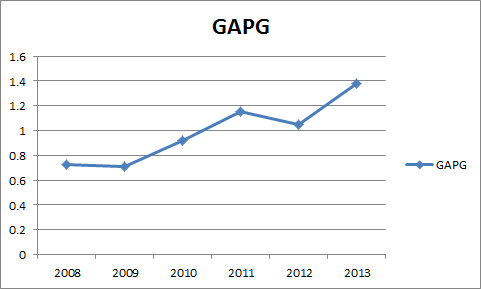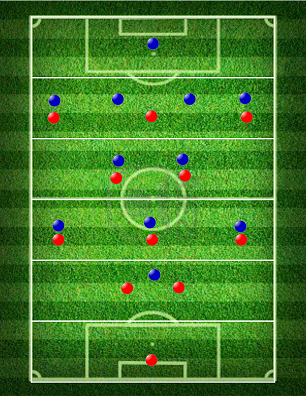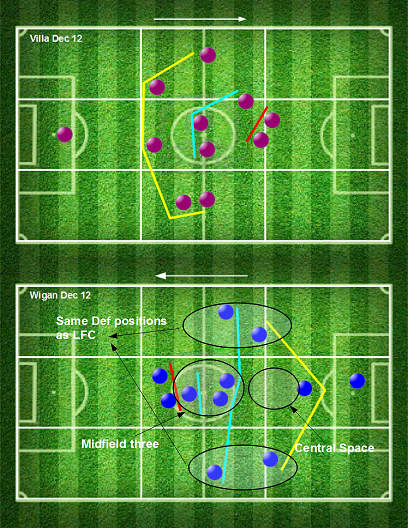The Back-Three Question
Posted by PhaseOfPlay on December 30, 2012, 06:11:38 am
The Back-Three QuestionThere has been a lot of discussion about the defensive frailties of Liverpool this year. Statistically, we have conceded 1.37 goals per game this season. This is a poor tally for a club with ambitions of getting among the CL places. There are a few possible reasons for this – new manager, new methods, off-form players, or a system flaw, among others. We will look at the system being used and the repercussions of the organisation of the system, as the other factors could quite reasonably happen under any system (player form, new manager and methods could cause a defensive regression regardless of the system used – for example, Hodgson played a tight back four sitting on the 18 yard line and conceded roughly the same amount of goals per game as Rodgers’ team has, currently). What we will be looking at is the rationale behind using a three-back system in order to help reduce goals against, while preserving the attacking principles that Rodgers wants to develop at the club. It would hopefully explain why some of us have mentioned it a few times, and show that there is more to it other than just “winning the physical battle” or some such description. When looked at closely, it is actually a possible solution that would not only solidify certain aspects of our defence, but it would have the knock-on effect of strengthening our possession game and allow us the patience required to play the way Rodgers wants.
Defensive Record –
Although a lot of people argue over the merits of statistics, the data is unbiased and can show trends and progression/regression over a period of time. Although you don’t have to know or use statistics to know when something is getting better or worse, you can use them to show by how much things are getting better or worse. With this in mind, it might be useful to look at the trend of the last 5 years under various managers. We will look at season 2010-11 as an overall season, although Kenny had a significantly better goal per game against average than Hodgson did. But as an overall trendline, we can see how our defence has performed year after year since our best period under Rafa (GAPG = Goals Against Per Game):

As we can see, there has been an upward trend in terms of goals conceded, briefly halted in Kenny’s full year of management. The key point is the massive jump from last year to this year. When we compare the two years, though, we have to ask what is different – do we have new central defenders, or a new system? Clearly, the system is the main thing that’s changed, and because of this, it is worth looking into what the system is and how it might influence the defensive aspects of the game
The Principles of Rodgers’ Defence -
Regardless of any use of an “8-Zones” interpretation, the first thing we need to know about Rodgers ideal system, and the one he is working towards, is that it is essentially a 2-3-2-3 formation, just like Barcelona’s. In terms of tactics, as much as we can talk about ideas of possession, control, and pressure, the basic reason for the splitting up of this formation into four bands that separate the fullbacks from the central defenders is the prominence of the 4-2-3-1 formation in Spain. This is also an indication as to why the formation is experiencing structural weaknesses for Liverpool in the Premier League (where the formation is not so prominent). As we can see below, the 2-3-2-3 conforms to the basic tactical rule of outnumbering the forward line by one defender, matching the shape of the midfield, and maintaining width up front:

What we can see here is that, when faced with a 4-2-3-1, the 2-3-2-3 formation is quite capable of dealing with the structure of the opposition. The problems exist when the other team doesn’t play the same game:


So, structurally, we can see that the system could run into problems when other teams play anything other than 4-2-3-1. On the other hand, the system and how it applies to principles of defence is at a disadvantage against these other formations too. This is largely due to the centrebacks being played so far apart, but also because we play a high line – our average positions for our back four are frequently very much into the middle third rather than the back third. Additionally, we play a pressure game which requires the attackers to be forward thinking:

With this in mind, we can see that a number of factors are present – high pressure attack, high line, and split centrebacks. This leads to some very vulnerable spaces, as we can see below:


The space behind Lucas and between Skrtel and Agger are sensitive to direct play patterns from the opposition. This is compounded by teams that play with two forwards, as Villa did against us (and Stoke to a slightly lesser extent – their forwards are staggered, so it looks like they play with one, but the shadow striker is closely connected to the movement of the forward). It also means that Lucas is caught in a no-man’s land defensively. As the attack pushes up to press the opposition defence, he becomes separated from the two attacking mids. The fullbacks push up simultaneously, too, so the job of covering for them for all intents and purposes falls on the defensive mid. The defensive mid, though, also has to step into the gap between the back two to become a third defender, but without actually being the central defender itself. This is what creates the sensitive space for opposition forwards to play in. It also affects Lucas’ ability (and Allen’s before him) to do his defensive midfield job effectively. In terms of the midfield, we can see that another sensitive space is created in the midfield three, and depending on the personnel in the attacking midfield positions, it leaves the defensive mid absolutely isolated. Stoke played to this perfectly by abandoning a balanced formation and intensively overloading that space around Lucas, which allowed them to create a lot of pressure on our possession in the defensive third, especially as Enrique was having an anxious game in possession. So we can see that although the intention of pressure is there, we miss something that is vitally important in top level defending – compactness. We can see examples of Compactness from other teams below:


The Liverpool midfield is split vertically through the functional flaw of the 2-3-2-3; the defence is split horizontally in the possession phase. The wing-forwards are true wing-forwards and don’t have much detail to drop back and double up on the opposition wide players, regardless of what their opposition fullback does on their side. The fundamentals of Rodgers’ defensive system are sound, but the application of them are disturbed by the tactical variation of the Premier League – a variation comparable to Serie A teams, and we know that the flexibility of a Serie A team can cause us problems at times. Flexibility of formation is something Rodgers should look at more, because it solves structural problems without sacrificing the principles of play he wants to imbue in the team (high pressure compact defence, temporized possession, 3rd attacker penetration).
The Back-Three Solution –
The reason why a three-back formation would work as an option against certain teams is clear from the above – it achieves several structural corrections in one move, without detracting from how Rodgers wants the ball to be moved, and without sacrificing the pressure game – in fact, it possibly even enhances it. The reasons for this are as follows –
- The third central defender occupies the sensitive space between Agger and Skrtel and behind Lucas
- Allowing Lucas to push up more defines his role clearly, and allows him to play more naturally
- Allowing Lucas to get closer to the attacking mids eliminates the sensitive midfield space in between the attacking mids and the defensive mid
- The three defenders allows for better balanced cover across the width of the field, allowing the fullbacks the luxury of greater concentration on their attacking roles
- The fullbacks having greater focus on their attacking roles allows the possession game to build better, which forces the other team back
- When the other team is forced back, it allows the pressure game to be operated more efficiently, as the opposition will have less release passes when they win the ball, leaving them with a long ball as their only realistic option before they are under pressure. Because these long balls are rushed and played blind, they will be played inaccurately. They will also go to one of the three channels, each of which will be marshaled by one of the back three, with no large gaps for the opposition forwards to play through
For these reasons, it can be seen that there are certain situations, at least, where a back three system would work better for what Rodgers is trying to achieve. It is pragmatic without being compromising of the principles of play. It has the element of surprise that keeps opposition managers guessing. Spatially, it is a smart use of resources. It also enhances elements of Rodgers’ preferred style of play. For contrast, Wigan played a 3-4-1-2 versus Villa, and although the system itself wasn’t the contributory factor in their win, there is a lesson to be learned in terms of the shape of Liverpool’s system against 2-forward attacks:

As we can see, Villa played the same system as they did against us. The problem for them, though, was that Wigan placed players in the spaces they were able to hurt us, with their central defender playing almost like a Sweeper. They also maintained a midfield three, which is ideal for a possession/passing team.
Conclusion -
So we can see that the idea of playing three defenders against certain teams is not just a matter of trying to match their physicality, or trying to be pragmatic, or even having to change the pattern of play Rodgers prefers, or his philosophy. Tactically, it is a sensible solution to a problem that is inherent in our structure when playing against certain types of Premier League teams. Most Premier League teams are not tactically flexible, preferring a single system of play with one minor adjustment, usually the design of the midfield and forwards. In order to combat that, and protect the vital central area while preserving our style of play, a shift to a back three system for specific games and opponents would be very prudent and sensible. It would be a positive move, rather than a reactionary one, and one that would bring many direct and indirect benefits. Of course, the quality/condition/personality of the players also has an impact, but in terms of tactics and systems, it would at least address, by default, a key area that is vulnerable to smart managers and players when they face us. It is something that one would hope Rodgers would address sooner rather than later – it is not a secret vulnerability, but it is easily solved.
LFC forum latest
-
Remembrance Birthdays for the 97. by Medellin
-
Previous incidents and near misses at Hillsborough by The Tenacious Kennedy
-
Ronnie King (The 98th Angel) by mikeb58
-
'The Pain of Injustice': Excellent Article from David Conn by No666
-
Justice Delayed is Justice Denied by PhilScraton
-
15 April 2023 by PhilScraton
-
Hillsborough article in The Athletic. by Alan_X
-
David Conn Long Read by Circa1892
-
RIP Andrew Devine by Tepid T₂O
-
Rest In Peace David Church, father of Gary Church - funeral Tue Nov 14th by 24/7